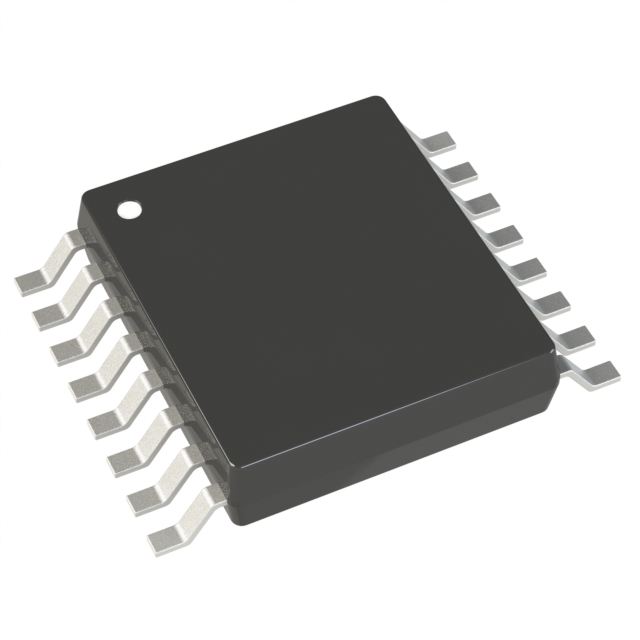AD5282BRUZ200-R7
Product Overview
Category
AD5282BRUZ200-R7 belongs to the category of digital potentiometers.
Use
It is used as a programmable resistor in various electronic circuits.
Characteristics
- Digital control interface
- Wide resistance range
- Low power consumption
- High resolution
- Non-volatile memory
- Small package size
Package
AD5282BRUZ200-R7 is available in a small outline integrated circuit (SOIC) package.
Essence
The essence of AD5282BRUZ200-R7 lies in its ability to provide precise and programmable resistance values in electronic circuits.
Packaging/Quantity
It is typically packaged in reels or tubes, with a quantity of 2500 units per reel.
Specifications
- Resistance Range: 0Ω to 200Ω
- Resolution: 1Ω
- Supply Voltage: 2.7V to 5.5V
- Operating Temperature Range: -40°C to +125°C
- Interface: I2C-compatible
Detailed Pin Configuration
AD5282BRUZ200-R7 has the following pin configuration:
- VDD: Power supply voltage
- SDA: Serial data input/output for I2C communication
- SCL: Serial clock input for I2C communication
- GND: Ground connection
- A0: Address bit 0 for device addressing
- A1: Address bit 1 for device addressing
- WP: Write protect pin for non-volatile memory
- RDY: Ready/busy status output
Functional Features
- Programmable resistance value through digital control interface
- Non-volatile memory to store resistance settings
- Low power consumption for energy-efficient operation
- High resolution for precise resistance adjustments
- I2C-compatible interface for easy integration into digital systems
Advantages and Disadvantages
Advantages
- Precise and programmable resistance control
- Non-volatile memory ensures resistance settings are retained even when power is lost
- Low power consumption helps in energy-efficient designs
- High resolution allows for fine-grained resistance adjustments
- Easy integration into digital systems with the I2C-compatible interface
Disadvantages
- Limited resistance range compared to some other digital potentiometers
- Requires additional components for voltage reference and amplification in certain applications
Working Principles
AD5282BRUZ200-R7 utilizes a combination of digital control and analog circuitry to provide programmable resistance. The digital control interface, based on the I2C protocol, allows users to set the desired resistance value. The non-volatile memory ensures that the resistance setting is retained even when power is lost. The analog circuitry inside the device adjusts the resistance based on the digital input, providing precise resistance control.
Detailed Application Field Plans
AD5282BRUZ200-R7 finds applications in various fields, including:
- Audio equipment: Volume control, tone adjustment
- Industrial automation: Calibration, sensor trimming
- Test and measurement: Programmable loads, signal conditioning
- Communication systems: Gain control, impedance matching
- Automotive electronics: Climate control, lighting control
Detailed and Complete Alternative Models
Some alternative models to AD5282BRUZ200-R7 include:
- AD5262: Dual-channel digital potentiometer
- AD8403: Quad-channel digital potentiometer with SPI interface
- MCP401X: Single-channel digital potentiometer with I2C interface
- MAX5486: Dual-channel digital potentiometer with push-button interface
- X9C104: Single-channel digital potentiometer with up/down control
These alternative models offer similar functionality and can be considered based on specific application requirements.
Word count: 536 words
Lista 10 Vanliga frågor och svar relaterade till tillämpningen av AD5282BRUZ200-R7 i tekniska lösningar
Sure! Here are 10 common questions and answers related to the application of AD5282BRUZ200-R7 in technical solutions:
Q: What is the AD5282BRUZ200-R7? A: The AD5282BRUZ200-R7 is a dual-channel, I2C digital potentiometer with a resistance range of 0 to 200 ohms.
Q: What are the typical applications of the AD5282BRUZ200-R7? A: The AD5282BRUZ200-R7 is commonly used in audio equipment, instrumentation, industrial control systems, and other applications that require precise resistance adjustments.
Q: How does the AD5282BRUZ200-R7 communicate with a microcontroller? A: The AD5282BRUZ200-R7 uses the I2C interface to communicate with a microcontroller or other devices.
Q: Can the AD5282BRUZ200-R7 be used as a variable gain amplifier? A: Yes, the AD5282BRUZ200-R7 can be used to adjust the gain of an amplifier circuit by varying the resistance in the feedback path.
Q: What is the resolution of the AD5282BRUZ200-R7? A: The AD5282BRUZ200-R7 has a resolution of 256 steps, allowing for fine-grained adjustment of resistance.
Q: Is the AD5282BRUZ200-R7 digitally controlled? A: Yes, the AD5282BRUZ200-R7 is digitally controlled, meaning that resistance adjustments can be made through software commands.
Q: Can multiple AD5282BRUZ200-R7 devices be daisy-chained together? A: Yes, multiple AD5282BRUZ200-R7 devices can be daisy-chained together using the I2C interface, allowing for control of multiple potentiometers with a single microcontroller.
Q: What is the power supply voltage range for the AD5282BRUZ200-R7? A: The AD5282BRUZ200-R7 operates from a single power supply voltage ranging from 2.7V to 5.5V.
Q: Does the AD5282BRUZ200-R7 have non-volatile memory? A: Yes, the AD5282BRUZ200-R7 has non-volatile memory that retains the resistance settings even when power is removed.
Q: Can the AD5282BRUZ200-R7 be used in automotive applications? A: Yes, the AD5282BRUZ200-R7 is qualified for automotive applications and can withstand the harsh operating conditions typically found in automotive environments.
Please note that these answers are general and may vary depending on specific application requirements.


